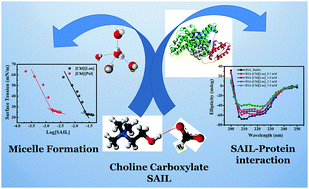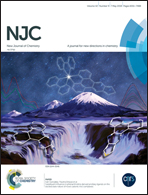Aggregation behaviour of biocompatible choline carboxylate ionic liquids and their interactions with biomolecules through experimental and theoretical investigations†
Abstract
Choline carboxylates are an important class of bio-derived ionic liquids (ILs) having potential applications in the pharmaceutical sector. Therefore, detailed knowledge of the physicochemical properties of this class of ILs and their mixtures with biomolecules is highly desired with a focus on sustainability and environmental impact. In view of this, a series of surface-active ILs (SAILs) based on choline carboxylates, viz. choline laurate ([Chl][Lau]) and choline palmitate ([Chl][Pal]), were synthesized. Various techniques such as surface tension measurements, conductivity measurements, dynamic light scattering (DLS), and rheology were employed to get detailed information about their self-assembly and viscoelastic behaviours in aqueous medium. A set of surface and thermodynamic parameters of these SAILs in water was determined, which revealed the superior surface activity of [Chl][Pal] compared to [Chl][Lau]. Ab initio and natural bond orbital (NBO) calculations manifested larger binding and hydrogen-bonding energies of [Chl][Lau]–water compared to [Chl][Pal]–water. Consequently, it is more difficult for [Chl][Lau] to self-aggregate in water. The steady-state and oscillatory rheological measurements demonstrated notable differences in solution viscosities in these systems. The size of the micellar aggregates was significantly affected by the hydrophobicity of carboxylate anions and concentration of SAILs. Finally, the interactions of these SAILs with bovine serum albumin (BSA) were systematically investigated in aqueous medium. The quenching effect of these SAILs on tryptophan moieties of BSA along with the information on the secondary structural conformation was monitored through fluorescence and circular dichroism techniques to understand the binding strength and mechanism. Understanding the aggregation behaviour and molecular level interactions of choline carboxylate SAILs with BSA is required to explore their potential applications in biotechnology.



 Please wait while we load your content...
Please wait while we load your content...